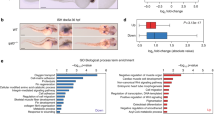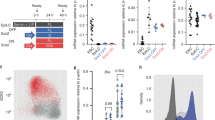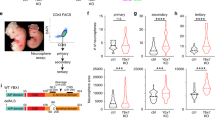Abstract
The generation of neurons constitutes the foundation of nervous system development, yet the mechanisms underlying neurogenesis are not well established. The HMG-box transcription factors Sox1, Sox2 and Sox3 (Sox1–3) have previously been shown to suppress neurogenesis by maintaining neural cells in an undifferentiated state. Here we report that another HMG-box protein, Sox21, has the opposite activity and promotes neuronal differentiation. Using genetic studies in the chick embryo, we found that Sox21 mediates this function by counteracting the activity of Sox1–3. Accordingly, the balance of Sox21 and Sox1–3 activities determines whether neural cells remain as progenitors or commit to differentiation. Proneural basic helix-loop-helix proteins are essential for the establishment of neuronal fates. We now show that proneural proteins promote neurogenesis by upregulating Sox21 expression. These data establish a key role for Sox21 in the progression of neuronal differentiation and indicate that an important role of proneural proteins is their capacity to upregulate the expression of Sox21.
This is a preview of subscription content, access via your institution
Access options
Subscribe to this journal
Receive 12 print issues and online access
$209.00 per year
only $17.42 per issue
Buy this article
- Purchase on Springer Link
- Instant access to full article PDF
Prices may be subject to local taxes which are calculated during checkout






Similar content being viewed by others
References
Kintner, C. Neurogenesis in embryos and in adult neural stem cells. J. Neurosci. 22, 639–643 (2002).
Bertrand, N., Castro, D.S. & Guillemot, F. Proneural genes and the specification of neural cell types. Nat. Rev. Neurosci. 3, 517–530 (2002).
Davis, R.L. & Turner, D.L. Vertebrate hairy and Enhancer of split related proteins: transcriptional repressors regulating cellular differentiation and embryonic patterning. Oncogene 20, 8342–8357 (2001).
Koyano-Nakagawa, N., Kim, J., Anderson, D. & Kintner, C. Hes6 acts in a positive feedback loop with the neurogenins to promote neuronal differentiation. Development 127, 4203–4216 (2000).
Bae, S., Bessho, Y., Hojo, M. & Kageyama, R. The bHLH gene Hes6, an inhibitor of Hes1, promotes neuronal differentiation. Development 127, 2933–2943 (2000).
Farah, M.H. et al. Generation of neurons by transient expression of neural bHLH proteins in mammalian cells. Development 127, 693–702 (2000).
Lee, J.E. et al. Conversion of Xenopus ectoderm into neurons by NeuroD, a basic helix-loop-helix protein. Science 268, 836–844 (1995).
Ma, Q., Kintner, C. & Anderson, D.J. Identification of neurogenin, a vertebrate neuronal determination gene. Cell 87, 43–52 (1996).
Kamachi, Y., Uchikawa, M., Collignon, J., Lovell-Badge, R. & Kondoh, H. Involvement of Sox1, 2 and 3 in the early and subsequent molecular events of lens induction. Development 125, 2521–2532 (1998).
Pevny, L.H., Sockanathan, S., Placzek, M. & Lovell-Badge, R. A role for SOX1 in neural determination. Development 125, 1967–1978 (1998).
Uwanogho, D. et al. Embryonic expression of the chicken Sox2, Sox3 and Sox11 genes suggests an interactive role in neuronal development. Mech. Dev. 49, 23–36 (1995).
Bylund, M., Andersson, E., Novitch, B.G. & Muhr, J. Vertebrate neurogenesis is counteracted by Sox1–3 activity. Nat. Neurosci. 6, 1162–1168 (2003).
Graham, V., Khudyakov, J., Ellis, P. & Pevny, L. SOX2 functions to maintain neural progenitor identity. Neuron 39, 749–765 (2003).
Kamachi, Y., Uchikawa, M. & Kondoh, H. Pairing SOX off: with partners in the regulation of embryonic development. Trends Genet. 16, 182–187 (2000).
Uchikawa, M., Kamachi, Y. & Kondoh, H. Two distinct subgroups of Group B Sox genes for transcriptional activators and repressors: their expression during embryonic organogenesis of the chicken. Mech. Dev. 84, 103–120 (1999).
Rex, M., Uwanogho, D.A., Orme, A., Scotting, P.J. & Sharpe, P.T. cSox21 exhibits a complex and dynamic pattern of transcription during embryonic development of the chick central nervous system. Mech. Dev. 66, 39–53 (1997).
Hamburger, V. The stage series of the chick embryo. Dev. Dyn. 195, 273–275 (1992).
Fode, C. et al. The bHLH protein NEUROGENIN 2 is a determination factor for epibranchial placode-derived sensory neurons. Neuron 20, 483–494 (1998).
Roztocil, T., Matter-Sadzinski, L., Alliod, C., Ballivet, M. & Matter, J.M. NeuroM, a neural helix-loop-helix transcription factor, defines a new transition stage in neurogenesis. Development 124, 3263–3272 (1997).
Caccamo, D.V. et al. An immunohistochemical study of neuropeptides and neuronal cytoskeletal proteins in the neuroepithelial component of a spontaneous murine ovarian teratoma. Primitive neuroepithelium displays immunoreactivity for neuropeptides and neuron-associated beta-tubulin isotype. Am. J. Pathol. 135, 801–813 (1989).
Tsuchida, T. et al. Topographic organization of embryonic motor neurons defined by expression of LIM homeobox genes. Cell 79, 957–970 (1994).
Tanabe, Y., William, C. & Jessell, T.M. Specification of motor neuron identity by the MNR2 homeodomain protein. Cell 95, 67–80 (1998).
Ericson, J. et al. Pax6 controls progenitor cell identity and neuronal fate in response to graded Shh signaling. Cell 90, 169–180 (1997).
Yokota, Y. Id and development. Oncogene 20, 8290–8298 (2001).
Dubreuil, V., Hirsch, M.R., Jouve, C., Brunet, J.F. & Goridis, C. The role of Phox2b in synchronizing pan-neuronal and type-specific aspects of neurogenesis. Development 129, 5241–5253 (2002).
Smith, S.T. & Jaynes, J.B. A conserved region of engrailed, shared among all en-, gsc-, Nk1-, Nk2- and msh-class homeoproteins, mediates active transcriptional repression in vivo. Development 122, 3141–3150 (1996).
Berk, A.J. et al. Mechanisms of viral activators. Cold Spring Harb. Symp. Quant. Biol. 63, 243–252 (1998).
Hannon, G.J. RNA interference. Nature 418, 244–251 (2002).
Paddison, P.J., Caudy, A.A., Bernstein, E., Hannon, G.J. & Conklin, D.S. Short hairpin RNAs (shRNAs) induce sequence-specific silencing in mammalian cells. Genes Dev. 16, 948–958 (2002).
Mizuguchi, R. et al. Combinatorial roles of olig2 and neurogenin2 in the coordinated induction of pan-neuronal and subtype-specific properties of motoneurons. Neuron 31, 757–771 (2001).
Novitch, B.G., Chen, A.I. & Jessell, T.M. Coordinate regulation of motor neuron subtype identity and pan-neuronal properties by the bHLH repressor Olig2. Neuron 31, 773–789 (2001).
Komatsu, T. et al. Small ubiquitin-like modifier 1 (SUMO-1) modification of the synergy control motif of Ad4 binding protein/steroidogenic factor 1 (Ad4BP/SF-1) regulates synergistic transcription between Ad4BP/SF-1 and Sox9. Mol. Endocrinol. 18, 2451–2462 (2004).
Ohba, H. et al. Sox21 is a repressor of neuronal differentiation and is antagonized by YB-1. Neurosci. Lett. 358, 157–160 (2004).
Kageyama, R. & Nakanishi, S. Helix-loop-helix factors in growth and differentiation of the vertebrate nervous system. Curr. Opin. Genet. Dev. 7, 659–665 (1997).
Tajbakhsh, S., Rocancourt, D., Cossu, G. & Buckingham, M. Redefining the genetic hierarchies controlling skeletal myogenesis: Pax-3 and Myf-5 act upstream of MyoD. Cell 89, 127–138 (1997).
Ma, Q., Fode, C., Guillemot, F. & Anderson, D.J. Neurogenin1 and neurogenin2 control two distinct waves of neurogenesis in developing dorsal root ganglia. Genes Dev. 13, 1717–1728 (1999).
Kim, J., Lo, L., Dormand, E. & Anderson, D.J. SOX10 maintains multipotency and inhibits neuronal differentiation of neural crest stem cells. Neuron 38, 17–31 (2003).
Beranger, F., Mejean, C., Moniot, B., Berta, P. & Vandromme, M. Muscle differentiation is antagonized by SOX15, a new member of the SOX protein family. J. Biol. Chem. 275, 16103–16109 (2000).
Schaeren-Wiemers, N. & Gerfin-Moser, A. A single protocol to detect transcripts of various types and expression levels in neural tissue and cultured cells: in situ hybridization using digoxigenin-labelled cRNA probes. Histochemistry 100, 431–440 (1993).
Acknowledgements
We thank H. Kondoh for Sox21 chick cDNA, and we are grateful to J. Ericson, T. Perlmann and members of the Muhr lab for discussions and comments on the manuscript. J.M. is supported by The Swedish Natural Research Council, The Swedish Foundation for Strategic Research, the Ake Wiberg Research Foundation, the Magnus Bergvall Foundation, the Jeansson Research Foundations and the Ludwig Institute for Cancer Research.
Author information
Authors and Affiliations
Corresponding author
Ethics declarations
Competing interests
The authors declare no competing financial interests.
Supplementary information
Supplementary Fig. 1
Id2 represses the generation of neurons but not Sox21 activity. (PDF 1070 kb)
Supplementary Fig. 2
Synergistic activity of Sox21 and Ngn2 during neurogenesis. (PDF 2333 kb)
Supplementary Fig. 3
Proposed model of a transcriptional pathway regulating neurogenesis. (PDF 814 kb)
Rights and permissions
About this article
Cite this article
Sandberg, M., Källström, M. & Muhr, J. Sox21 promotes the progression of vertebrate neurogenesis. Nat Neurosci 8, 995–1001 (2005). https://doi.org/10.1038/nn1493
Received:
Accepted:
Published:
Issue Date:
DOI: https://doi.org/10.1038/nn1493
This article is cited by
-
PHF3 regulates neuronal gene expression through the Pol II CTD reader domain SPOC
Nature Communications (2021)
-
The Prevailing Role of Topoisomerase 2 Beta and its Associated Genes in Neurons
Molecular Neurobiology (2021)
-
SoxB2 in sea urchin development: implications in neurogenesis, ciliogenesis and skeletal patterning
EvoDevo (2018)
-
SoxC transcription factors: multifunctional regulators of neurodevelopment
Cell and Tissue Research (2018)
-
Transcriptome profiling reveals expression signatures of cranial neural crest cells arising from different axial levels
BMC Developmental Biology (2017)



